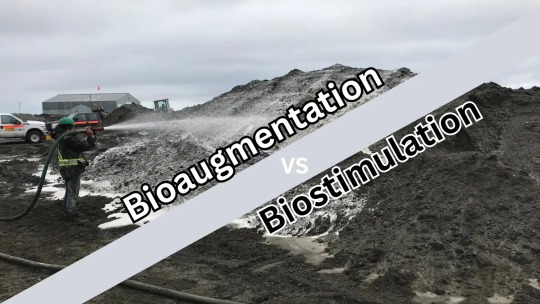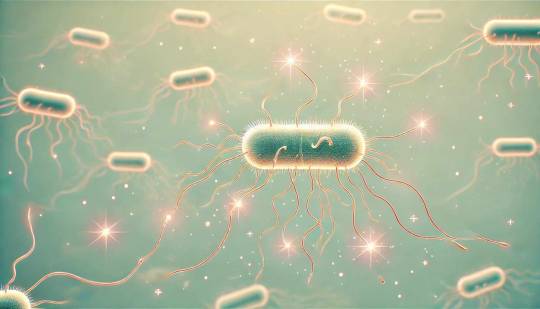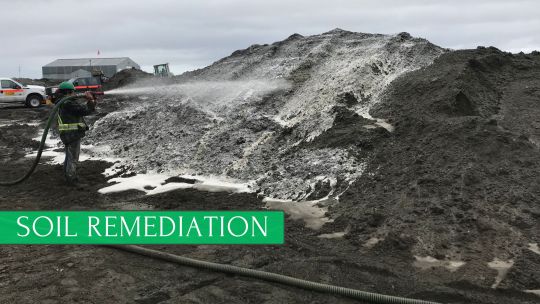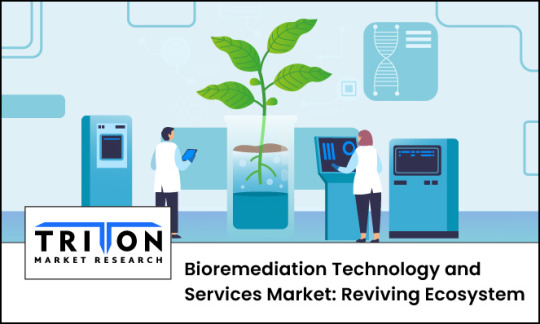#Bioremediation technologies
Explore tagged Tumblr posts
Text

Unraveling the Depths of Bioaugmentation and Biostimulation: A Comprehensive Comparison
Introduction:
If you've ever delved into the field of environmental biotechnology, you've likely stumbled across the terms "bioaugmentation" and "biostimulation". These sophisticated approaches to environmental remediation are both aimed at enhancing natural processes to treat contamination. But what exactly distinguishes one from the other? In this article, we will delve into the specifics of Bioaugmentation vs Biostimulation, breaking down their definitions, applications, and key differences.
Understanding Bioaugmentation:
Bioaugmentation, in its simplest form, is the introduction of a group of natural microbial strains or a genetically engineered variant into an environment to enhance the rate of pollutant degradation. These microbial strains, often referred to as 'augments', are known for their specialized ability to degrade contaminants that the existing microbial community cannot effectively handle. This technique is frequently employed to address the contamination of soil and water bodies with organic pollutants such as oil spills and certain types of industrial waste.
Diving into Biostimulation:
On the other hand, biostimulation involves the stimulation of indigenous microbial communities already present in the environment by providing nutrients, electron acceptors, or substrates that enhance their activity. Unlike bioaugmentation that adds new organisms to an ecosystem, biostimulation works with the existing microbial population, encouraging their growth and pollutant degradation capabilities. Often used in environmental cleanup efforts, biostimulation can enhance the breakdown of a broad range of pollutants, including petroleum hydrocarbons and heavy metals.
Bioaugmentation Vs Biostimulation: A Comparative Study:
Now that we understand the fundamentals of both processes, it's time to compare them head-to-head.
Techniques Involved: While bioaugmentation is about introducing specific microbial strains to boost pollutant degradation, biostimulation works by providing necessary nutrients or substrates to stimulate the indigenous microbial population.
Scope of Application: Both techniques are used in environmental remediation, especially for soil and groundwater. Bioaugmentation has a slight edge in cases where specific contaminants require particular microbial strains for degradation. Biostimulation, however, is often favored for broader applications, given that it enhances the overall microbial activity and not just that of specific strains.
Economic Aspects: Bioaugmentation requires the cultivation and addition of specific microbial strains, which can be costly and technically demanding. On the contrary, biostimulation usually involves adding relatively inexpensive nutrients or substrates, making it a more economically feasible option in many cases.
Environmental Impact: Bioaugmentation involves adding new organisms, which raises concerns about the impact on the existing ecosystem and the potential for creating imbalances. Biostimulation, working with existing microbial communities, is generally viewed as having a less disruptive impact on ecosystem balance.
Effectiveness: Both techniques have proven effective in various scenarios, but their success heavily depends on site-specific conditions. For instance, bioaugmentation's effectiveness might be hindered by the inability of the added microbes to survive in the new environment. Biostimulation's success, on the other hand, could be limited by the potential growth of undesired microbial communities.
Conclusion:
Bioaugmentation and biostimulation, though conceptually distinct, share a common goal: to utilize biological processes for environmental remediation. Choosing between them demands a clear understanding of the contamination at hand, the existing microbial community, and the economic and environmental implications of each approach. As scientists continue to explore these fascinating techniques, our ability to heal the environment using nature's own tools will only continue to improve.
#Bioaugmentation#Biostimulation#Bioremediation technologies#Environmental Remediation#Pollution control methods#Bioaugmentation vs Biostimulation#Benefits of bioaugmentation#Benefits of biostimulation#Bioaugmentation in habitat restoration#Biostimulation for pollution control#Limitations of bioaugmentation#Limitations of biostimulation#Bioaugmentation-assisted biostimulation#Microbial bioremediation#Sustainable environmental practices#Choosing between bioaugmentation and biostimulation#Understanding bioaugmentation#Understanding biostimulation#Industrial waste management#Oil spill cleanup techniques
5 notes
·
View notes
Text




Inside the Chernobyl Exclusion Zone, scientists have discovered a black fungus capable of feeding on deadly gamma radiation.
Scientists believe this mechanism could be used to make biomimicking substances that both block radiation from penetrating and turn it into a renewable energy source. (x)
How it works:
Melanin and Radiation: The fungus contains melanin, a pigment also found in human skin, which appears to capture ionizing radiation and convert it into chemical energy—a process scientifically termed "radiosynthesis," somewhat analogous to photosynthesis in plants but using radiation instead of sunlight.
Radiotrophic Behavior: This extraordinary capability, known as "radiotrophic" behavior, allows the fungus to use radiation as an energy source to grow and sustain itself, even in high-radiation environments like the remnants of the Chernobyl Nuclear Power Plant.
Implications:
Bioremediation: These radiation-consuming fungi could potentially be used in cleaning up radioactive waste sites, offering a biological approach to absorbing and potentially neutralizing harmful radiation.
Space Exploration: Their remarkable ability to survive in extreme radiation environments makes them a fascinating subject for astrobiology. They could provide critical insights into the potential for life on radiation-exposed planets or help develop innovative strategies to protect astronauts from cosmic radiation during long-duration space missions.
Medicine and Research: The intricate mechanisms by which these fungi process and potentially harness radiation could inspire groundbreaking advances in radioprotective medicines, materials science, and our understanding of biological radiation resistance.
p.s. It's not just fungus. The overall family of extremophiles that live on or despite radiation includes both fungi and bacteria, and different species have different mechanisms for absorbing or tolerating radiation. (x)
#chernobyl#black fungus#cryptococcus neoformans#radiotrophic fungus#gamma radiation#radiation-eating fungus#extreme environments#science#biology#fungi#melanin#radiotrophy#chernobyl disaster#bioremediation#astrobiology#space exploration#extreme survival#radiation research#environmental science#radiation#microbiology#extremophiles#nature is metal#scientific discovery#weird science#organism adaptation#nuclear biology#biomimicry#research#technology
15 notes
·
View notes
Text
What is Bioremediation and its Importance in Environmental Conditions
Bioremediation is a natural, eco-friendly method that removes environmental contaminants using microorganisms and plants.It is cost-effective and sustainable, helping purify soil and water while restoring ecological balance.Though it faces challenges like slow processing, it remains a promising environmental solution.Bioremediation plays a vital role in creating a cleaner and greener planet.
Click here: https://vanamindiafoundation.org/37/blog_detail
#Bioremediation#Environmental Cleanup#Eco-Friendly Solutions#Soil Remediation#Water Purification#Microorganisms in Bioremediation#Green Technology#Sustainable Environment#Environmental Sustainability#Natural Pollution Cleanup#Phytoremediation#Microbial Remediation
0 notes
Text
The study of microorganisms found in natural surroundings is known as environmental microbiology.
#omnipublication#books#education#youwritewepublish#Environmental Microbiology#Microbes#microorganisms#Ecosystems#Biogeochemistry#Bioremediation#Extreme Environments#Technological Developments
1 note
·
View note
Text
The Bioremediation Technology Services Market in 2023 is US$ 15.02 billion, and is expected to reach US$ 32.55 billion by 2031 at a CAGR of 10.20%.
#Bioremediation Technology Services Market#Bioremediation Technology Services Market Share#Bioremediation Technology Services Market Size
0 notes
Text
Bioremediation Technology and Services: Market Analysis 2024-2032

According to Triton Market Research, the Global Bioremediation Technology and Services Market report is sectioned by Type (In-situ Bioremediation, Ex-situ Bioremediation), Service (Wastewater Remediation, Soil Remediation, Oilfield Remediation, Other Services), Technology (Biostimulation, Phytoremediation, Bioreactors, Bioaugmentation, Fungal Remediation, Land-based Treatments), and Regional Outlook (North America, Europe, Middle East and Africa, Asia-Pacific, Latin America).
The report highlights the Market Summary, Industry Outlook, Impact Analysis, Porter’s Five Forces Analysis, Key Buying Impact Analysis, Industry Components, Market Maturity Analysis, Key Market Strategies, Market Drivers, Challenges, Opportunities, Analyst Perspective, Competitive Landscape, Research Methodology and scope, Global Market Size, Forecasts & Analysis (2024-2032).
Based on Triton’s analysis, the global bioremediation technology and services market is set to advance at a CAGR of 7.97% during the forecasting phase 2024-2032.
Bioremediation technique encompassing phytoremediation, bioaugmentation, and biostimulation, offers an eco-friendly approach to tackle diverse environmental challenges, serving as a sustainable alternative to conventional remediation techniques.
Rising integration of nanotechnology and growing innovation in metagenomics and genomics are creating ample opportunities for the bioremediation technology and services market. Nanotechnology enables the development of advanced materials and techniques with properties tailored for environmental cleanup, such as increased surface area for adsorption, enhanced reactivity, and improved transport of contaminants. These nanomaterials can target specific pollutants, allowing for more precise and targeted remediation efforts. This significantly widens the scope of the studied market globally.
However, uncertainty pertaining to the site and the long duration of the process restricts the development of the bioremediation technology and services market.
Asia-Pacific is estimated to become the fastest-growing region globally. The surge in population alongside urbanization and industrial expansion, coupled with heightened oil and gas consumption, has fostered numerous contaminated sites. Consequently, heightened awareness regarding the adverse effects of pollution and governmental regulations aimed at environmental preservation has elevated the need for bioremediation services, which significantly fuels the market’s growth.
The notable companies thriving in the bioremediation technology and services market include Carus Group Inc, Sevenson Environmental Services Inc, Aquatech International LLC, Drylet Inc, Xylem Inc, Soilutions Ltd, Verde Environmental Group, RT Environmental Services Inc, Regenesis Remediation Solutions, and Ivey International Inc.
The market is currently dominated by established players who wield significant control. Any prospective newcomer would face substantial barriers to entry, including high capital requirements for technical products and labor, as well as a considerable time frame needed to secure a foothold in the market. Given the robust competition, establishing a new presence becomes a formidable challenge. As a result, the threat posed by new entrants remains low.
0 notes
Note
Why is everyone suddenly getting taller?
-🌊
Thank you for your questions, and please accept our apologies for the delayed response.
To answer the current question Magic.
To answer your other inquiry on water pollution:
At Drake Industries and Wayne Enterprises, we are deeply committed to restoring Gotham’s environment, with a particular focus on rehabilitating its polluted waters. For decades, industrial byproducts have been irresponsibly dumped into Gotham Harbor, causing significant environmental damage. Compounding this issue are the frequent attacks by rogue elements, which have introduced highly toxic substances such as Joker Toxin and Fear Toxin into the water. These cumulative factors have led to severe ecological degradation, resulting in the loss of marine life and the alteration of the harbor’s natural ecosystem.
To address this critical challenge, we collaborate closely with the U.S. Environmental Protection Agency (EPA) to develop and implement more effective methods for cleaning Gotham’s waters. Currently, we employ a wide range of advanced treatment systems, including but not limited to oil skimmers, sorbents, booms and barriers, dispersants, bioremediation agents, filtration systems, chemical treatments, ion exchange units, reverse osmosis systems, electrocoagulation systems, and vacuum trucks. While the number of systems in use may seem extensive, the severity of historical and ongoing pollution in Gotham’s waters necessitates such a comprehensive approach. Furthermore, we continue to innovate and develop new technologies to enhance our efforts and achieve long-term environmental restoration.
Thank you for your interest in this vital work if any further detail is needed please send another ask or message us at [public business email I'm too lazy to make up].
We remain dedicated to safeguarding Gotham’s environment for future generations.
Tim Drake
16 notes
·
View notes
Text
Genetically Modified Bacteria Produce Energy From Wastewater

E. Coli is one of the most widely studied bacteria studied in academic research. Though most people probably associate it with food/water borne illness, most strains of E. Coli are completely harmless. They even occur naturally within your intestines. Now, scientists at EPFL have engineered a strain of E. Coli that can generate electricity.
The survival of bacteria depends on redox reactions. Bacteria use these reactions to interconvert chemicals in order to grow and metabolize. Since bacteria are an inexhaustible natural resource, many bacterial reactions have been industrially implemented, both for creating or consuming chemical substrates. For instance, you may have heard about researchers discovering bacteria that can break down and metabolize plastic, the benefits of which are obvious. Some of these bacterial reactions are anabolic, which means that they need to be provided external energy in order to carry it out, but others are catabolic, which means that the reactions actually create energy.
Some bacteria, such as Shewanella oneidensis, can create electricity as they metabolize. This could be useful to a number of green applications, such as bioelectricity generation from organic substrates, reductive extracellular synthesis of valuable products such as nanoparticles and polymers, degradation of pollutants for bioremediation, and bioelectronic sensing. However, electricity producing bacteria such as Shewanella oneidensis tend to be very specific. They need strict conditions in order to survive, and they only produce electricity in the presence of certain chemicals.
The method that Shewanella oneidensis uses to generate electricity is called extracellular electron transfer (EET). This means that the cell uses a pathway of proteins and iron compounds called hemes to transfer an electron out of the cell. Bacteria have an inner and outer cell membrane, so this pathway spans both of them, along with the periplasmic space between. In the past, scientists have tried to engineer hardier bacteria such as E. Coli with this electron-generating ability. It worked… a little bit. They were only able to create a partial EET pathway, so the amount of electricity generated was fairly small.
Now, the EPFL researchers have managed to create a full pathway and triple the amount of electricity that E. Coli can produce. "Instead of putting energy into the system to process organic waste, we are producing electricity while processing organic waste at the same time -- hitting two birds with one stone!" says Boghossian, a professor at EPFL. "We even tested our technology directly on wastewater that we collected from Les Brasseurs, a local brewery in Lausanne. The exotic electric microbes weren't even able to survive, whereas our bioengineered electric bacteria were able to flourish exponentially by feeding off this waste."
This development is still in the early stages, but it could have exciting implications both in wastewater processing and beyond.
"Our work is quite timely, as engineered bioelectric microbes are pushing the boundaries in more and more real-world applications" says Mouhib, the lead author of the manuscript. "We have set a new record compared to the previous state-of-the-art, which relied only on a partial pathway, and compared to the microbe that was used in one of the biggest papers recently published in the field. With all the current research efforts in the field, we are excited about the future of bioelectric bacteria, and can't wait for us and others to push this technology into new scales."
151 notes
·
View notes
Text

Electric Bacteria: Harnessing Nature's Microscopic Power Plants for a Sustainable Future
Electric bacteria, or electrogenic microbes, are fascinating organisms capable of generating electricity as part of their natural metabolic processes. Found in diverse environments such as soil, freshwater, and even the human gut, these bacteria can convert organic compounds into electrical energy. This unique ability is primarily observed in species like Shewanella and Geobacter, which use conductive proteins to transfer electrons to external electrodes, functioning like microscopic power plants.
Shewanella oneidensis and Geobacter sulfurreducens are notable examples. These bacteria can form biofilms on electrodes, creating a microbial fuel cell that generates electricity. This phenomenon is not just a scientific curiosity but has practical applications. For instance, microbial fuel cells can be used in wastewater treatment plants to both clean water and generate electricity simultaneously. Additionally, electrogenic bacteria are being explored for bioremediation, helping to clean up polluted environments by breaking down contaminants and converting them into less harmful substances.
The potential of electric bacteria extends to sustainable energy solutions. By harnessing their natural abilities, researchers aim to develop innovative technologies that offer renewable energy sources. The intersection of microbiology and energy technology could lead to breakthroughs that address some of the world's pressing environmental challenges.
References:
Lovley, D. R. (2012). Electromicrobiology. Annual Review of Microbiology, 66, 391-409.
Nealson, K. H., & Rowe, A. R. (2016). Electromicrobiology: Realities, grand challenges, goals and predictions. Microbial Biotechnology, 9(5), 595-600.
Logan, B. E. (2009). Exoelectrogenic bacteria that power microbial fuel cells. Nature Reviews Microbiology, 7(5), 375-381.
5 notes
·
View notes
Text
The Promising Future of Biochemistry Research: Unveiling the Mysteries of Life
Biochemistry, the scientific study of the chemical processes and substances that occur within living organisms, stands at the precipice of a remarkable era of discovery and innovation. As technology continues to advance and our understanding of molecular biology deepens, the future of biochemistry research holds the potential to revolutionize medicine, agriculture, energy production, and environmental sustainability.
Precision Medicine and Personalized Therapies: Biochemistry research is ushering in an era of personalized medicine, where treatments are tailored to an individual's unique genetic makeup and biochemical profile. The elucidation of intricate molecular pathways, protein structures, and genetic mutations empowers researchers to develop targeted therapies for diseases like cancer, neurodegenerative disorders, and rare genetic conditions. Precision medicine promises more effective treatments with fewer side effects, bringing hope to patients worldwide.
Synthetic Biology and Biotechnology: The fusion of biochemistry with engineering has given rise to synthetic biology and biotechnology. Researchers are designing novel biological systems, enzymes, and pathways for various applications, such as biofuel production, bioremediation, and drug synthesis. This field holds the potential to address pressing global challenges, including sustainable resource utilization and environmental restoration.
Structural Biology and Drug Discovery: Advances in biochemistry techniques, such as cryo-electron microscopy and X-ray crystallography, have revolutionized our ability to visualize the three-dimensional structures of biomolecules. This knowledge is invaluable for rational drug design, enabling scientists to develop new therapeutic agents that precisely target disease-causing molecules. The future holds the promise of faster and more accurate drug discovery, leading to improved treatment options for a wide range of ailments.
Neurobiochemistry and Brain Health: Exploring the intricate biochemical processes underlying brain function is shedding light on neurological disorders and paving the way for potential interventions. As our understanding of neurotransmitters, signaling pathways, and neuroplasticity deepens, biochemistry research could unlock innovative therapies for conditions such as Alzheimer's disease, Parkinson's disease, and mood disorders.
Biochemistry in Agriculture: Biochemistry is playing a pivotal role in enhancing crop yields, developing disease-resistant plants, and optimizing nutrient utilization in agriculture. By unraveling the molecular mechanisms governing plant growth, stress responses, and interactions with microorganisms, researchers are contributing to global food security and sustainable farming practices.
The future of biochemistry research is undeniably exciting, as it holds the key to transformative breakthroughs across a multitude of sectors. From personalized medicine to sustainable biotechnology and beyond, our growing knowledge of biochemical processes promises to reshape the way we address challenges and improve the quality of life for people around the world. As technology and collaboration continue to drive innovation in this field, the mysteries of life are gradually being unraveled, paving the way for a brighter and more promising future.
#science#biochemistry#research scientist#research paper#research laboratory#education#learn#learning#research chemicals#infographic#research newswire#scifi#scifiedit#scifiart
3 notes
·
View notes
Text

Unearthing the Power of Soil Remediation: A Promising Path towards Environmental Sustainability
The health of our planet is intricately linked to the quality of its soil, an aspect that is often overlooked. Soil pollution presents a significant environmental concern, affecting agricultural productivity, water quality, and ultimately, human health. However, the innovative field of soil remediation holds the key to reclaiming contaminated land and fostering a sustainable future.
Soil remediation, a sector of environmental science, focuses on purifying and revitalizing the soil. It encompasses various techniques to remove harmful pollutants, such as heavy metals, petroleum products, pesticides, and more, from contaminated soil. The ultimate aim is to restore the soil to a state where it can once again support healthy growth and biodiversity.
There are several methods of soil remediation, each tailored to the type and extent of soil contamination.
1. Excavation and Disposal
As a direct approach, this method involves physically removing the contaminated soil and disposing of it in designated landfills. Although it's an immediate solution, it merely transfers the contamination issue from one place to another, leading to concerns about its environmental sustainability.
2. Soil Washing
This technique uses water, sometimes mixed with other substances, to wash away contaminants. It's particularly effective for treating soils contaminated with heavy metals or certain kinds of organic pollutants. However, the process requires treatment of the resulting washwater to avoid secondary contamination.
3. Bioremediation
One of the most promising soil remediation strategies, bioremediation, employs natural processes to clean up contaminated soil. Specific microorganisms or plants (phytoremediation) are used to absorb, break down, or immobilize contaminants. This method is eco-friendly and holds great potential for large-scale applications.
4. Thermal Desorption
Thermal desorption involves heating soil to evaporate the pollutants, which are then collected and treated separately. This process is ideal for soils contaminated with volatile organic compounds, but it requires substantial energy input.
Soil remediation's significance extends far beyond environmental preservation. Healthy soil is critical for a functioning ecosystem, contributing to plant growth, water filtration, and climate regulation. Moreover, with the escalating global population, the need for arable land is at an all-time high. Through soil remediation, previously unusable land can be restored, strengthening food security and promoting sustainable land use.
Simultaneously, soil remediation helps protect groundwater resources. Soil acts as a natural filter, and contaminants present in the soil can leach into groundwater over time, posing serious health risks. By removing these pollutants, soil remediation safeguards our water supply.
In the grand scheme of climate change, soil remediation plays a pivotal role. Soil holds three times as much carbon as the atmosphere. Techniques like bioremediation not only remove contaminants but also improve soil health, increasing its capacity to store carbon and thereby helping to mitigate climate change.
In conclusion, soil remediation is not merely a sector of environmental science; it is a tool of hope for our planet. It embodies the mantra of "heal the soil, heal the planet," and underscores our responsibility to protect the environment. With continued research and technological advancements in soil remediation techniques, we can make strides towards a sustainable future.
Let's invest in soil remediation - for our health, for our food, and for our planet.
#Soil Remediation Techniques#Methods of Soil Remediation#Importance of Soil Remediation#Biological Soil Remediation#Chemical Soil Remediation#Thermal Soil Remediation#Soil Contamination Solutions#Future of Soil Remediation#Nanoremediation for Soil#Prevention of Soil Pollution#Soil Degradation and Remediation#Phytoremediation Techniques#Environmental Restoration Techniques#Soil Clean-up Methods#Soil Sustainability Practices#Eco-friendly Soil Remediation#Industrial Waste Soil Remediation#Soil Remediation Technologies#Innovations in Soil Remediation#Impact of Soil Remediation
2 notes
·
View notes
Text
PFAS Remediation Services Market Growth Analysis, Market Dynamics, Key Players and Innovations, Outlook and Forecast 2025-2032
The global PFAS Remediation Services market was valued at USD 801.68 million in 2023 and is projected to reach USD 1,633.92 million by 2029, growing at a CAGR of 12.60% during the forecast period. This robust growth is fueled by heightened awareness of PFAS-related health risks and the growing stringency of environmental regulations globally.
Get free sample of this report at : https://www.intelmarketresearch.com/download-free-sample/867/pfas-remediation-services
PFAS Remediation Services refer to specialized environmental services aimed at the removal or neutralization of Per- and Polyfluoroalkyl Substances (PFAS) in contaminated sites such as soil, surface water, and groundwater. PFAS are synthetic chemicals commonly found in industrial applications and consumer products including firefighting foams, non-stick cookware, textiles, and food packaging. These "forever chemicals" are resistant to environmental degradation and have been linked to adverse health and ecological impacts.
Remediation strategies involve physical, chemical, and biological treatments such as activated carbon filtration, ion exchange resins, bioremediation, and thermal destruction. The primary objective of these services is to mitigate environmental and public health risks by reducing PFAS concentrations to regulatory-safe levels.
Emerging economies are also increasing their investment in environmental remediation, contributing to market expansion. Furthermore, the increasing discovery of PFAS contamination in groundwater supplies and landfills has accelerated the demand for reliable remediation solutions.
Market Dynamics (Drivers, Restraints, Opportunities, and Challenges)
Drivers
Regulatory Push: Stricter environmental laws, particularly in the U.S. (EPA PFAS Strategic Roadmap) and the EU, are catalyzing investments in PFAS cleanup.
Public Awareness and Litigation: Rising public concern and legal actions around PFAS contamination are forcing industries to adopt remediation services.
Industrial Expansion: Growing industrial and military activities are contributing to PFAS discharge, thereby increasing the need for cleanup services.
Restraints
High Treatment Costs: The implementation of advanced PFAS remediation technologies such as thermal oxidation and ion exchange can be capital-intensive.
Technical Complexity: The diverse chemical nature and persistence of PFAS compounds make remediation technically challenging and time-consuming.
Opportunities
Technological Innovation: Development of cost-effective and eco-friendly remediation technologies presents a major growth opportunity.
Global Adoption: Rising contamination in developing nations like India, China, and Southeast Asia opens new market avenues.
Challenges
Lack of Uniform Standards: Inconsistencies in PFAS regulation across countries can limit the uniform application of remediation services.
Detection Difficulties: Identifying trace-level PFAS contamination remains a technical barrier in efficient remediation.
Regional Analysis
North America
North America leads the PFAS remediation market, driven by regulatory mandates from the U.S. Environmental Protection Agency (EPA) and proactive state-level policies. Several remediation projects are underway at military installations and industrial sites.
Europe
Europe is emerging as a significant market due to the EU’s REACH regulation targeting PFAS substances and growing investment in water safety infrastructure.
Asia-Pacific
Countries like China, India, and Japan are ramping up their environmental management efforts, with increasing instances of PFAS detection in water supplies spurring demand for cleanup services.
South America, Middle East & Africa
These regions are still nascent but present untapped potential. With increased environmental awareness and foreign direct investment in industrial sectors, PFAS remediation services are expected to gain momentum.
Competitor Analysis (in brief)
The PFAS remediation landscape is characterized by fragmented competition with several global and regional players. Major companies such as Evoqua Water Technologies, AECOM, and Veolia hold significant market shares owing to their extensive service portfolios and global presence.
Evoqua Water Technologies LLC: Known for its cutting-edge water treatment solutions, including granular activated carbon and ion exchange.
Arcadis and AECOM: Leverage engineering expertise for integrated site assessment and remediation.
Veolia and Wood PLC: Offer turnkey remediation services globally.
Strategic partnerships, acquisitions, and technological innovations are the core tactics adopted by these players to strengthen their market position.
Recent Developments
May 24, 2023 Xylem Inc, a global water technology leader, announced that it has finalized the acquisition of Evoqua Water Technologies Corp., a mission-critical water treatment solutions and services leader, in an all-stock deal worth around $7.5 billion. The merger forms the world's most sophisticated platform of capabilities to help solve customers' and communities' most significant water challenges.
Apr. 4, 2024, Clean Harbors, Inc. the premier provider of environmental and industrial services across North America, unveiled its "Total PFAS Solution" to meet all customers' requirements for managing PFAS (per- and poly-fluorinated alkyl substances), also known as forever chemicals.
June 4, 2024, AECOM, the global go-to infrastructure consulting leader, and Aquatech, a water and process technology leader globally, have signed an agreement to step up the roll-out of per- and polyfluoroalkyl substances (PFAS) destruction technology. This partnership unites years of experience, coupling AECOM's top-ranked ENR number-one water and environmental practice with pioneering DE-FLUORO™ PFAS destruction technology and Aquatech's industry-leading process and electrochemical technology expertise and background in scaling end-to-end technology solutions and services. This fusion of two well-established industry players will drive DE-FLUORO faster as a market-leading PFAS destruction solution.
April 13, 2024, Veolia, the largest private water services operator in the United States, has achieved a new record in its treatment of America's drinking water of per- and polyfluoroalkyl substances (PFAS) chemicals, with over 30 facilities now reporting no detectable levels of regulated PFAS chemicals. The advanced effort entails new treatment mounted on 17 drinking water wells in the state of New York, with construction under way on further projects in four states as Veolia continues to tackle PFAS contamination in drinking water supplies nationwide.
Global PFAS Remediation Services Market: Market Segmentation Analysis
This report provides a deep insight into the global PFAS Remediation Services Market, covering all its essential aspects. This ranges from a macro overview of the market to micro details of the market size, competitive landscape, development trend, niche market, key market drivers and challenges, SWOT analysis, value chain analysis, etc.
The analysis helps the reader to shape the competition within the industries and strategies for the competitive environment to enhance the potential profit. Furthermore, it provides a simple framework for evaluating and assessing the position of the business organization. The report structure also focuses on the competitive landscape of the Global PFAS Remediation Services Market. This report introduces in detail the market share, market performance, product situation, operation situation, etc., of the main players, which helps the readers in the industry to identify the main competitors and deeply understand the competition pattern of the market.
In a word, this report is a must-read for industry players, investors, researchers, consultants, business strategists, and all those who have any kind of stake or are planning to foray into the PFAS Remediation Services Market in any manner.
Market Segmentation (by Type)
Physical/Chemical Treatment
Bioremediation
Thermal Treatment
Other
Market Segmentation (by Remidation Approach)
Ex-situ Remediation
In-situ Remediation
Market Segmentation (by Application)
Groundwater Remediation
Soil Remediation
Surface Water Remediation
Landfill Remediation
Industrial Site Remediation
Market Segmentation (by End Use Industry)
Municipal Sector
Industrial Sector
Commercial Sector
Residential Sector
Others
Key Company
Evoqua Water Technologies LLC
AECOM
Golder Associates
Arcadis
Wood PLC
Jacobs Engineering
Ship and Shore Environmental, Inc.
Veolia
BETA Group
Enviropacific
TRS Group
GWT
Minerals Technologies Inc.
Dragun Corporation
Ventia
Geographic Segmentation
North America (USA, Canada, Mexico)
Europe (Germany, UK, France, Russia, Italy, Rest of Europe)
Asia-Pacific (China, Japan, South Korea, India, Southeast Asia, Rest of Asia-Pacific)
South America (Brazil, Argentina, Columbia, Rest of South America)
The Middle East and Africa (Saudi Arabia, UAE, Egypt, Nigeria, South Africa, Rest of MEA
FAQ: Global PFAS Remediation Services Market
Q1: What is the current market size of the global PFAS Remediation Services market?
As of 2023, the global PFAS Remediation Services market is valued at USD 801.68 million.
Q2: What is the projected value of the PFAS Remediation Services market by 2029?
The market is expected to reach approximately USD 1,633.92 million by 2029, driven by stringent regulations and increasing awareness of PFAS-related health hazards.
Q3: What is the expected compound annual growth rate (CAGR) of this market?
The market is projected to grow at a CAGR of 12.60% during the forecast period from 2023 to 2029.
Q4: What are PFAS and why is their remediation important?
PFAS (Per- and Polyfluoroalkyl Substances) are synthetic chemicals found in various consumer products. Due to their persistence in the environment and potential health risks, effective remediation is crucial to protect public health and comply with environmental standards.
Q5: What are the main types of PFAS remediation services available in the market?
The market is segmented into three primary types:
Physical/Chemical Treatment
Bioremediation
Thermal Treatmen
Get free sample of this report at : https://www.intelmarketresearch.com/energy-and-natural-resources/867/pfas-remediation-services
0 notes
Text
Synthetic Biology Market Set to Surpass USD 164.24 Billion by 2030, Driven by Biotech Innovation and Sustainability Demand
Market Overview
The global synthetic biology market is projected to expand significantly in the coming years. Estimates suggest that the market size will grow from USD 89.62 billion in 2025 to approximately USD 164.24 billion by 2030, reflecting a robust compound annual growth rate (CAGR) of 12.88% during this period. This rapid expansion is driven by technological innovations, decreasing costs of DNA synthesis and sequencing, and increasing applications across various industries.
Key Growth Drivers
1. Technological Advancements: Breakthroughs in genome editing tools, such as CRISPR-Cas9, and the integration of AI and machine learning are accelerating research and development in synthetic biology. These technologies enable precise manipulation of genetic material, leading to innovative solutions in medicine, agriculture, and bio-manufacturing.
2. Healthcare Innovations: Synthetic biology is revolutionizing healthcare by facilitating the development of personalized medicine, advanced diagnostics, and novel therapeutics. Applications include gene therapies, synthetic vaccines, and engineered probiotics, which are at the forefront of medical innovation .
3. Sustainable Solutions: The ability to engineer microorganisms to produce biofuels, biodegradable plastics, and sustainable agricultural products addresses pressing environmental challenges. Synthetic biology offers promising solutions to climate change, food security, and the need for eco-friendly materials .
Regional Insights
North America: Currently leading the global market, North America's dominance is attributed to substantial investments in research and development, a strong biotechnology infrastructure, and supportive government initiatives. The region's focus on personalized medicine and sustainable technologies continues to drive market growth
Asia-Pacific: Emerging as the fastest-growing region, Asia-Pacific's synthetic biology market is propelled by increasing investments in biotechnology, expanding research infrastructure, and rising demand for healthcare innovations.
India: The country's focus on PCR technology and increasing collaborations in the biotechnology sector are key factors contributing to this growth.
Applications Across Industries
Healthcare: Development of gene therapies, personalized medicine, and synthetic vaccines.
Agriculture: Engineering of high-yield crops and advanced pest management solutions to meet global food demands.
Industrial Biotechnology: Production of biofuels, biodegradable plastics, and other sustainable materials.
Environmental Applications: Bioremediation and development of eco-friendly solutions to address environmental challenges.
Challenges and Considerations
Despite its potential, the synthetic biology industry faces challenges, including ethical concerns, biosafety risks, and regulatory hurdles. The intentional or unintentional release of synthetic organisms into the environment poses significant biosafety risks, such as the potential creation of antibiotic-resistant superbugs. Additionally, ethical issues surrounding genetic manipulation and the need for updated regulatory frameworks are critical considerations for the industry's sustainable growth.
Future Outlook
The synthetic biology market is on a trajectory of remarkable growth, with its applications poised to transform various sectors fundamentally. Continued investments in research and development, coupled with advancements in technology and supportive policies, will be instrumental in overcoming current challenges and unlocking the full potential of synthetic biology. As the industry evolves, it will play a pivotal role in addressing some of the most pressing global issues, from healthcare to environmental sustainability.
0 notes
Text
Global Contaminated Soil Remediation Technology Market Report: Trends, Opportunities and Forecast 2025-2031
Contaminated soil remediation technologies consist of a comprehensive set of processes designed to reduce, remove, or neutralize hazardous substances in contaminated soil. These technologies are essential for restoring ecological balance and protecting human health. Contamination can come from a variety of sources, including industrial waste, chemical spills, improper waste disposal, and excessive use of pesticides and fertilizers. With increasing regulations and global efforts toward sustainable development, the demand for efficient and innovative remediation technologies is steadily increasing.
Market Overview and Size
The global contaminated soil remediation technology market was valued at USD 68.8 billion in 2024 and is expected to reach USD 107.6 billion by 2030, growing at a CAGR of 6.5% during the forecast period . This growth is attributed to the rapid advancement in industrialization, rapid urban development, and increasing awareness about soil health and environmental sustainability.
The need to restore contaminated land for residential, commercial, industrial, and agricultural uses is growing worldwide. Governments, environmental groups, and private organizations are investing heavily in advanced soil treatment technologies to address existing contamination and prevent further soil contamination.
Request a free sample copy:https://www.intelmarketresearch.com/download-free-sample/612/global-contaminated-soil-remediation-technology
Key Market Trends
Factors driving market growth
1. Strict environmental regulations and compliance measures International regulatory frameworks such as the U.S. Environmental Protection Agency’s (EPA) Comprehensive Environmental Response, Compensation, and Liability Act (CERCLA) and the European Union’s Soil Thematic Strategy have established a systematic and enforceable approach to addressing soil contamination. These regulations mandate remediation efforts for contaminated sites, creating a continued demand for technology-based solutions.
2. Accelerated industrial growth and urban expansion The rapid pace of industrialization and infrastructure development has a significant impact on soil pollution. Oil refining, chemical manufacturing, mining, and construction activities often leave behind hazardous residues. Urbanization, especially in developing countries, is increasing the need for land reuse and restoration.
3. Growing interest in environmental sustainability Companies are increasingly actively incorporating environmental, social, and governance (ESG) goals into their operations. As companies strive to reduce their ecological footprints, soil restoration using eco-friendly technologies such as phytoremediation and microbial treatment is gaining attention.
4. Advances in bioremediation and phytoremediation technologies Biological solutions are emerging as cost-effective and environmentally friendly alternatives to conventional chemical or mechanical processes. Innovations in using specific bacteria, fungi, and plants to decompose, absorb, or detoxify contaminants are improving the efficiency of biological remediation systems.
5. Increasing Brownfield Redevelopment Instances As land use in urban areas becomes limited, cities are increasingly focusing on brownfield redevelopment. This practice requires thorough soil remediation prior to construction or reuse, which is further driving the market growth.
Market constraints
Despite favorable market conditions, growth is hampered by certain constraints.
High implementation costs : Technologies such as chemical oxidation, soil vapor extraction, and thermal desorption require significant capital expenditures and long-term maintenance costs.
Time-consuming process : Many restoration techniques take a long time to produce results, especially biological methods and monitored natural decay methods.
Skills and awareness gaps in emerging economies : Lack of skilled professionals and lack of understanding of advanced recovery processes hinders market penetration in less developed regions.
Key Market Opportunities
1. Expansion in Developing Countries Emerging economies in Asia Pacific , Africa and Latin America are witnessing increased industrial activity without adequate environmental protection measures. This situation presents a huge opportunity for remediation technology providers to provide scalable and adaptable solutions.
2. Technology Integration with AI, IoT, and Remote Sensing Digital tools are increasingly being used to monitor soil conditions, predict contamination spread, and assess remediation effectiveness. Smart technologies enable real-time data collection and analysis, improving project accuracy and decision-making.
3. Expanding Public and Private Sector Funding Government grants, subsidies, and international cooperation programs focused on climate change response and sustainable development are injecting capital into soil restoration projects. Public-private partnerships are also contributing to technological innovation and deployment.
Market Challenges
Regulatory fragmentation across jurisdictions : Multinational rescue firms seeking standardization face challenges because regulations and enforcement mechanisms vary across countries.
Soil and site-specific constraints : Factors such as soil type, contaminant composition, moisture content, and climate significantly affect the feasibility and effectiveness of remediation methods.
Market segmentation
By application
Industrial site
Commercial site
Agricultural area
municipal project
By type of correction
On-site remediation : This is a method of treating the contaminated site through biological remediation or chemical injection.
Ex-situ remediation : Excavating the soil and treating it off-site using physical or thermal techniques.
By therapeutic techniques
Biological treatment (key sector) Technologies such as bioremediation and phytoremediation are preferred because they are low cost, cause minimal ecological disturbance, and are advantageous in terms of sustainability. Bacteria and plants are used to decompose or extract pollutants such as petroleum hydrocarbons and heavy metals.
Chemical treatment techniques such as chemical oxidation, soil washing, and stabilization are used where deeper, more aggressive decontamination is required.
Physical treatment methods such as thermal desorption, soil vapor extraction, and encapsulation are commonly used for contaminants such as volatile organic compounds (VOCs) and semivolatile organic compounds.
Effective for sites contaminated with persistent organic pollutants (POPs), this method involves heating the soil to break down the hazardous compounds.
Monitored Natural Attenuation (MNA) tracks natural processes that break down contaminants over time and is appropriate for low to medium risk sites.
By pollutant type
Organic pollutants : Includes petroleum hydrocarbons, pesticides, solvents, and industrial chemicals.
Weapon contaminants : Includes heavy metals such as lead, cadmium, mercury, and arsenic.
Mixed pollutants : Areas where both organic and inorganic pollutants are mixed, requiring a hybrid remediation strategy.
See the full report here:https://www.intelmarketresearch.com/energy-and-natural-resources-612
Local Market Insights
Asia Pacific – Leading the Global Market Asia Pacific leads the contaminated soil remediation technology market with a 49% share of the global market . Rapid industrialization and government programs targeting soil remediation in China , India , Japan , and South Korea have significantly increased the demand in the Asia Pacific region.
National plans in China, such as the Soil Pollution Prevention and Control Action Plan, are pushing for large-scale cleanup projects.
In India and Southeast Asia, increasing environmental regulations are accelerating the market growth.
North America – Adoption of Advanced Technologies The United States, with its stringent EPA (Environmental Protection Agency) regulations, plays a key role in the development and adoption of cutting-edge remediation technologies. The US market benefits from a robust environmental services industry and proactive legal framework.
Europe – A Sustainability-focused Market European countries prioritize sustainable land management. Countries such as Germany , France and the UK are investing in innovative biological and chemical remediation solutions that are aligned with the EU Soil Strategy 2030 goals.
Middle East & Africa | South America – Emerging Potential These regions are still in the developing stage, but are beginning to recognize the importance of soil restoration through awareness and international cooperation. Mining activities, oil exploration, and industrial expansion are the major factors driving demand in South America .
Key Players and Competitive Landscape
Some of the leading companies in the contaminated soil remediation technology market are:
reproduction
CETCO Correction Technology
Peroxychem (Evonik)
Remediation Products (RPI)
Tersus Environment
Dear Company
Remington Technologies
Biological soil restoration
Hepure Technologies
AST environment
ISOTEC Calibration Technology
Terra Systems, Inc.
Veolia – a global leader in environmental solutions providing integrated purification services.
Clean Harbors – Known for emergency response and hazardous waste disposal, now strengthened by the acquisition of HEPACO .
Golder Associates – renowned for its engineering consulting and technical expertise in contaminated site management.
These companies are focusing on mergers and acquisitions, regional expansion, and product innovation to remain competitive. Industry consolidation is on the rise, evidenced by strategic acquisitions that allow companies to diversify their service portfolios and expand their market presence.
Request a free sample copy:https://www.intelmarketresearch.com/download-free-sample/612/global-contaminated-soil-remediation-technology
See the full report here:https://www.intelmarketresearch.com/energy-and-natural-resources-612
Frequently Asked Questions (FAQ)
1. What is the current size of the contaminated soil remediation technology market? The market size is estimated at USD 68.8 billion in 2024 and is expected to grow to USD 107.6 billion by 2030, at a CAGR of 6.5%.
2. Who are the key players in the market? The key players include Regenesis, CETCO, PeroxyChem, RPI, Tersus Environmental, Veolia, Clean Harbors, Golder Associates, etc.
3. What are the factors driving the market growth? Key growth drivers include stringent environmental regulations, industrialization, public awareness, advancements in bioremediation technologies, and government support.
4. Which region is leading the global market? Asia Pacific leads the market with a 49% share, followed by North America and Europe.
5. What are the new trends in the industry? Key trends include the integration of AI and IoT for real-time monitoring, the rise of sustainable technologies such as bioremediation and phytoremediation, and the expansion of government funding and global partnerships for environmental restoration.
#Global Contaminated Soil Remediation Technology Market#Global Contaminated Soil Remediation Technology Market size#Global Contaminated Soil Remediation Technology Market share
0 notes
Text
https://tannda.net/read-blog/66440_bioremediation-technology-services-market-size-analysis-and-forecast-2031.html
The Bioremediation Technology Services Market in 2023 is US$ 15.02 billion, and is expected to reach US$ 32.55 billion by 2031 at a CAGR of 10.20%.
#Bioremediation Technology Services Market#Bioremediation Technology Services Market Trends#Bioremediation Technology Services Market Growth
0 notes
Text
Bioremediation Technology and Services Market: Reviving Ecosystem

As per the International Energy Agency, in 2022, global CO2 emissions from energy combustion and industrial processes increased by 0.9%, reaching a record high of 36.8 gigatonnes (Gt) .
Thus, a pivotal question emerges: What solution can effectively mitigate the environmental impact of industrial activities?
The alarming rise in emission levels has spurred a robust demand for bioremediation technologies and services. The bioremediation process uses natural organisms, primarily microbes, to break down hazardous substances into less toxic or non-toxic materials. It is an essential eco-friendly technology that harnesses the power of biological processes to mitigate environmental pollution. Accordingly, the Global Bioremediation Technology and Services Market is expected to advance at a CAGR of 7.97% during the 2024-2032 forecast period.
Bioremediation Technology and Services Market: Key Services in the Spotlight
From oil spill management to the restoration of urban brownfields, bioremediation techniques are being deployed worldwide to address a wide array of environmental issues. This widespread utilization underscores the versatility and effectiveness of bioremediation solutions in combating pollution, propelling the market forward.
Among the various services offered within the market, three have gained significant traction due to their critical importance and effectiveness:
Soil Remediation: As industrial contaminants increasingly compromise soil health, soil remediation has become a pivotal service. It involves various techniques to detoxify soils affected by chemical spills, industrial waste, and agricultural runoffs, thereby supporting ecological restoration and sustainable agriculture. Additionally, biochar can enhance bioremediation processes by providing a stable habitat for microbial communities that degrade pollutants. Its ability to improve soil properties, such as pH and moisture retention, further supports these microbial activities.
Recent advancements in bioremediation, particularly bioaugmentation for soil, have proven highly effective for degrading organic pollutants like petroleum hydrocarbons. This method not only reduces cleanup times but is also cost-effective. Its successful application across various contaminated sites highlights its versatility and efficiency in environmental restoration efforts.
Wastewater Remediation: This service is crucial for treating water bodies contaminated with industrial discharges, urban runoff, and sewage. The use of bioremediation processes in wastewater treatment helps in efficiently reducing pollutants, thus ensuring water safety and sustainability.
In one of its projects, Advanced BioTech employed BioWorld Liquid Optimizer and Hydrocarbon Digesting Microbes to oily wastewater in a tractor repair facility.
Oilfield Remediation: With the ongoing global reliance on fossil fuels, managing oil spillage and leaks is paramount. Bioremediation techniques used in oilfield remediation offer a potent solution for decomposing hydrocarbons, significantly minimizing environmental impacts.
Additionally, the use of microalgae in these processes not only supports the growth of oil-degrading bacteria but also directly engages in breaking down hydrocarbons through their metabolic processes. This dual role makes microalgae a promising tool in oil spill remediation, offering a more sustainable and less invasive alternative to traditional chemical methods.
Connect with our experts for a simplified analysis!
Asia-Pacific: A Dynamic Region in Bioremediation Market
The Asia-Pacific bioremediation technologies and services market is anticipated to witness the fastest growth, expected to attain a CAGR of 8.65% during 2024-2032. This growth is primarily driven by rapid industrialization and heightened environmental regulations. Countries such as China and India are leading the way, with significant investments in bioremediation research and the implementation of large-scale remediation projects. For example, China's commitment to remediate urban industrial sites has catalyzed the adoption of advanced bioremediation solutions, making it a key player in the regional market.
Looking Ahead: Innovations and Product Developments
Recent advancements in bioremediation technologies display innovative approaches to enhancing efficacy and application scopes. Notable developments include genetically engineered microbes with heightened capabilities to degrade specific pollutants and novel bioremediation products to tackle complex contaminations, including plastic waste. For instance, a recent breakthrough in 2023 involved the development of a microbial consortium capable of degrading polyethylene plastics, which constitute a significant portion of marine litter.
The bioremediation market is set to evolve with a focus on developing more targeted and efficient microbial agents, expanding the scope of pollutants that can be addressed. This progression will help tackle emerging contaminants while paving the way for more personalized and precise environmental remediation strategies.
Explore Our Latest Release for the 2024-2032 Market Analysis
FAQs:
Q1) What is bioremediation?
Bioremediation is a process that uses natural organisms to break down hazardous substances into less toxic or non-toxic materials.
Q2) Why is bioremediation important?
Bioremediation plays a critical role in managing environmental pollution by providing sustainable and effective methods to detoxify contaminated sites, thus helping to restore ecological balance and public health.
Q3) How does bioremediation help the environment?
Bioremediation helps the environment by reducing pollution levels, rehabilitating contaminated ecosystems, and promoting the recycling of waste materials into beneficial compounds.
0 notes